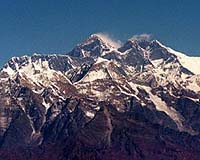| . |  |
. |
Corvallis OR (SPX) Aug 14, 2009 Researchers have largely put to rest a long debate on the underlying mechanism that has caused periodic ice ages on Earth for the past 2.5 million years - they are ultimately linked to slight shifts in solar radiation caused by predictable changes in Earth's rotation and axis. In a publication to be released Friday in the journal Science, researchers from Oregon State University and other institutions conclude that the known wobbles in Earth's rotation caused global ice levels to reach their peak about 26,000 years ago, stabilize for 7,000 years and then begin melting 19,000 years ago, eventually bringing to an end the last ice age. The melting was first caused by more solar radiation, not changes in carbon dioxide levels or ocean temperatures, as some scientists have suggested in recent years. "Solar radiation was the trigger that started the ice melting, that's now pretty certain," said Peter Clark, a professor of geosciences at OSU. "There were also changes in atmospheric carbon dioxide levels and ocean circulation, but those happened later and amplified a process that had already begun." The findings are important, the scientists said, because they will give researchers a more precise understanding of how ice sheets melt in response to radiative forcing mechanisms. And even though the changes that occurred 19,000 years ago were due to increased solar radiation, that amount of heating can be translated into what is expected from current increases in greenhouse gas levels, and help scientists more accurately project how Earth's existing ice sheets will react in the future. "We now know with much more certainty how ancient ice sheets responded to solar radiation, and that will be very useful in better understanding what the future holds," Clark said. "It's good to get this pinned down." To make their analysis, the researchers used an analysis of 6,000 dates and locations of ice sheets to define, with a high level of accuracy, when they started to melt. In doing this, they confirmed a theory that was first developed more than 50 years ago that pointed to small but definable changes in Earth's rotation as the trigger for ice ages. "We can calculate changes in the Earth's axis and rotation that go back 50 million years," Clark said. "These are caused primarily by the gravitational influences of the larger planets, such as Jupiter and Saturn, which pull and tug on the Earth in slightly different ways over periods of thousands of years." That, in turn, can change the Earth's axis - the way it tilts towards the sun - about two degrees over long periods of time, which changes the way sunlight strikes the planet. And those small shifts in solar radiation were all it took to cause multiple ice ages during about the past 2.5 million years on Earth, which reach their extremes every 100,000 years or so. Sometime around now, scientists say, the Earth should be changing from a long interglacial period that has lasted the past 10,000 years and shifting back towards conditions that will ultimately lead to another ice age - unless some other forces stop or slow it. But these are processes that literally move with glacial slowness, and due to greenhouse gas emissions the Earth has already warmed as much in about the past 200 years as it ordinarily might in several thousand years, Clark said. "One of the biggest concerns right now is how the Greenland and Antarctic ice sheets will respond to global warming and contribute to sea level rise," Clark said. "This study will help us better understand that process, and improve the validity of our models." Share This Article With Planet Earth
Related Links Oregon State University Beyond the Ice Age
 Climate cuts mountains down to size: study
Climate cuts mountains down to size: studyParis (AFP) Aug 13, 2009 Climate, and not the upward thrust of Earth's clashing tectonic plates, is the main factor limiting the height of mountains across the globe, according to a study published Thursday. The forbidding peaks of Mount Everest and K2, in other words, might have been even higher were it not for what scientists call the "buzzsaw" effect of glaciers that form when temperatures stay below a certain th ... read more |
|
| The content herein, unless otherwise known to be public domain, are Copyright 1995-2009 - SpaceDaily. AFP and UPI Wire Stories are copyright Agence France-Presse and United Press International. ESA Portal Reports are copyright European Space Agency. All NASA sourced material is public domain. Additional copyrights may apply in whole or part to other bona fide parties. Advertising does not imply endorsement,agreement or approval of any opinions, statements or information provided by SpaceDaily on any Web page published or hosted by SpaceDaily. Privacy Statement |